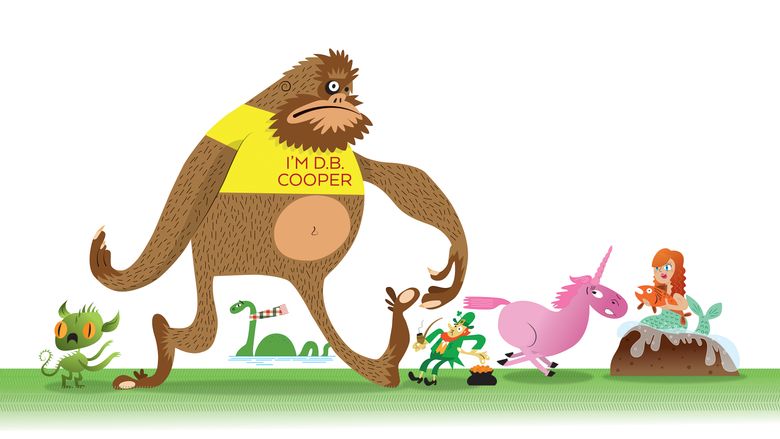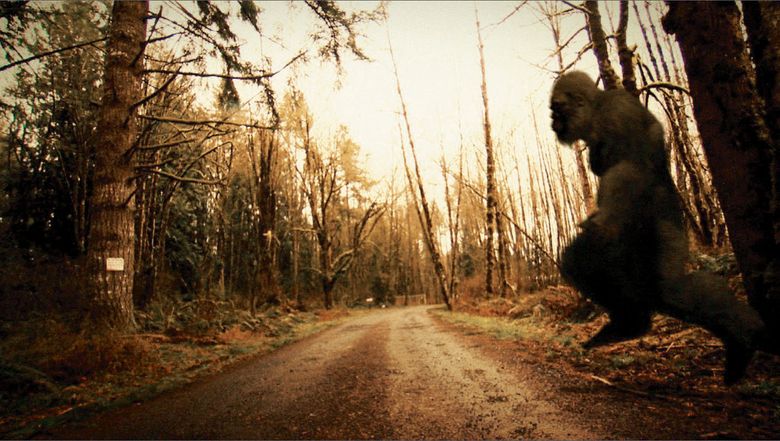Professional Bigfoot believers keep believing, and profiting, but they lack one thing — evidence.
Share story
CONSIDER THIS MINOR miracle: Over the course of a 30-year career that has often taken me deep into the woods, cracks and crannies of the Northwest — and even deeper into the mythology, paranoia and psycho-quirks of the region’s inhabitants — I have until now managed to avoid writing a piece exclusively about the legendary Sasquatch.
In the same spirit, I have never written a piece about flocks of flying hippos circling above Duvall, the miracle cure that is the copper bracelet or the discovery of what could be remains of Amelia Earhart at the bottom of a hip-deep pothole on Aurora Avenue North.
Equal weight for equal evidence, folks. Even-Steven.
We kid the Bigfooters here. But just a little.
Most Read Stories
Like everyone else upright and breathing, I have heard all the (mostly fake) tales, seen all the (fake) footprint castings, viewed the (fake) videos, heard recent (real) podcasts, even perused the (fake) “field guides.” I’ve also read large numbers of Sasquatch sightings, and believe that many reporters probably thought they saw something.
It just wasn’t an elusive long-lost subhuman, ape or shape-shifting alien species. Of this I am dead-dog nearly certain.
Can I prove this? Of course not. That’s not my job. But I am happy to be the guy who publicly looks into the glassy eyes of the professional true believers — especially those profiting from the mossy-roofed cottage industry feeding off this remarkably resilient fantasy — and issues a long-overdue ultimatum:
Show me a dead one, and we’ll talk.
SERIOUSLY, FOLKS. This overripe argument about the hairy ape-beast out back has long ago passed its best-by date. And if that question is seen as a put-up-or-shut-up demand, well, it is.
The imaginary Squatch was cute for a while, and any legend that spawns generations of coloring books, postcards, plush stuffed animals and fantastically bad late-night cable TV is harmless in my book — to a point.
In the present era of post-truth, what once qualified as playful mythology increasingly feels like overlooked symptoms of early onset societal nutjobbery, which at some critical-mass level becomes a dangerous thing. So please forgive me for attempting here to point at least one little LED headlamp beam of reason upon the logic-suffocating rot behind the Bigfoot industrial complex.
(He pauses to clear throat and pen the requisite qualifiers.)
An underlying premise here is that trying to prove a negative is sheer folly. No one can scientifically prove, for example, that a giraffe has never risen from the depths of Lake Union, marched down Westlake and taken a big dump atop the grassy knoll at Gas Works Park. But a reasonable person can apply her/his own probability mathematics to the question.
Accordingly: It’s impossible to prove that forested areas of the Northwest are not home to stealthy, apelike creatures standing 8 feet tall; weighing up to 800 pounds; constantly emitting putrid, gaseous odors; and prone to issuing earsplitting, guttural, train-whistle screams — yet managing at all times to conceal themselves more effectively than a thimble-sized hummingbird.
It is equally impossible to prove that the Mariners won’t win the 2019 World Series.
Some things, the sane people just know to be true.
As mentioned, the burden of proof here is not on me, or anyone else who finds better things to do than stumble around in the dark in the soggy hills of the Gifford Pinchot National Forest wearing night-vision goggles and carrying an AR-15.
All that’s on Team Squatch. And to that organization, I reissue the plea:
Please, oh please, just show me a dead one.
THE SAME POINT has been made, repeatedly, by the handful of scientists who took time away from real research to study the matter, and came to a near-unanimous conclusion: Despite a century of mythology surrounding Sasquatch “sightings” and supposed footprints and other circumstantial “evidence,” no scientifically acceptable proof of said mossbacked super ape exists. It just doesn’t.
This includes the absence of hair samples, scat and other matter that can be eliminated as belonging to other, well-known mammals. And it also includes the obvious starting point for the existence of any species, short of having one walk up to the Burke Museum and book its own display case: a nonliving, nonbreathing body, or any portion thereof.
Please don’t just take my word for it. In one admirable, comprehensive recap of the Squatch mythology, local writer Bruce Barcott (who is not insane), writing in Outside magazine, quoted pseudoscience debunker Michael Shermer, author and publisher of Skeptic magazine, as saying the lack of any identifiable body part renders the entire Sasquatch legend just that.
“New species of smaller organisms are found all the time, and most of the people I meet who are into cryptozoology seem OK,” Shermer told Barcott. “But Bigfoot really isn’t in that category anymore. After 100 years of anecdotes, stories, sightings and footprints, it’s time to cough up the body or forget it. To name a new species, we need to have a complete type specimen. But they’ve got nothing.”
The kicker: This was in 2002.
Seventeen years later, despite what, remarkably, appears to be only growing interest in “proving” the Squatch’s existence — and despite a bevy of what should be beneficial new technology, including drones; heat sensors; and, especially, remote-triggered wildlife cameras — what do “they” have today?
Zip. Nada. Zilch. The Big (University of Oregon logo) Zero.
NATURALLY, SOME PEOPLE will dispute that. In today’s world of digitally interconnected nut merchants, you can get someone to dispute anything (proof residing in your own hands, or on your own screen).
In response to any good, show-me-a-body taunt, Team Squatch will point to boxes of physical “evidence,” including casts of hundreds of supposed footprints (some of which do contain levels of fine detail that would be difficult to fake).
This, more than anything else, has kept the mystery alive.
True believers, in fact, insist the lack-of-body concerns are overblown. Reasoning: Dying Squatches know when they’re about to go to the big tree stump in the sky and make sure they never die at, say, Northgate Mall. A noted Bigfoot researcher, Jeffrey Meldrum, an anthropologist at Idaho State University (he picked up the mantle from late WSU anthropologist Grover Krantz), often explains that all traces of these unusually big bodies are then scattered and consumed by scavengers. And in the Northwest’s acidic soils, Bigfooters maintain, the bones eventually just … vanish.
Poof!
You don’t see skeletons of many other scarce creatures, such as grizzly bears, around, do you? (No, but unlike the mythical Squatch, they leave hair, scat and other evidence almost everywhere they exist.)
Others among the faithful offer their own, even-more-creative explanations for the lack of found Sasquatch bones: “No one is actively looking for them!” proclaims the Bigfoot Field Researchers Organization (BFRO).
Sasquatches, in fact, might have learned to bury their dead — and even cover their own tracks, the society speculates.
Well, OK, then.
SLAPPED UPSIDE the head with the absurdity of this argument, the ardent Bigfooter will open the door to his or her ultimate escape hatch, the same one that “explains” the lack of reliable recorded visual evidence: The woods out there are SO VAST. There are, this theory holds, entire areas of the Western United States onto which humans simply never set foot.
Not to get all technical, but there’s a scientific term for this sort of application of logic: Pfft.
Sure, the Northwest, which seems to lead the world in this crazed pursuit, is a big place, major parts of it still uninhabited, with large swatches rarely visited. But never? We should be so lucky.
The statement might have been truthy a couple hundred years ago. It isn’t true today, when tromping through the underbrush in the rain has gone from something one might be sentenced to do for committing a minor crime to something embraced by tens of thousands of people just looking for excuses to try out their new Pertex and Primaloft exoskeleton parkas and $800 GPS wristwatches.
Very few wild places in the Northwest today are not at least occasionally tromped through, flown over, or even surveilled by well-equipped backcountry fiends. And increasingly, even the wildest corners often are outfitted with high-tech stand-ins that, unlike people, never fall asleep on watch with a bottle of hooch between their boots.
Trail cameras, triggered by remote sensors and placed by wildlife observers or hunters, surely number in the thousands in the Cascades and Olympics, says Conservation Northwest’s Mitch Friedman, an expert on forest dwellers who does not count himself among the Bigfoot believers.
Total number of allegedly nocturnal giant apes happening by even one of these night-vision-capable traps and leaving that long-sought, verifiable image? You guessed it.
AND YET, they persist.
Bigfoot hucksters not only have failed to succumb to their deserved fate — fading farther into the woods than the subject of their obsession — they seem to have proliferated.
Stories in reputable media shops, including this one, continue to quote Squatch carnival barkers and document their activities because, well, people continue to search, and we don’t really know for sure … do we?
Countless Squatch-hunting societies exist around the globe, an inordinate share of them in Washington, Oregon and Idaho, the apparent Bermuda Triangle of thought and reason.
From these groups spring regular Bigfoot festivals and symposia, such as the annual International Bigfoot Conference in Kennewick, and the recent Spokane Valley Washington Sasquatch Roundup. A handful of outfitters will take curious seekers out on their own “expeditions” in Squatch “hot spots.”
Most prominent among the Northwest bigfooters assemblies is the above-mentioned BFRO, an organization claiming 3,000 members who field countless Bigfoot reports, the more relatively credible of which are posted online.
And the ongoing, ultimately pointless hunt for Bigfeet, naturally, is tailor-made for reality television, and producers of same for decades have gone into full ape mode (sorry) to meet this demand.
In one current incarnation, “Killing Bigfoot,” a team of Southern good ol’ boys tromps through the woods at night on a regular basis wearing camo and packin’ high-powered rifles, determined to do the world a favor by not just finding a Squatch, but dropping one in its expansive tracks.
(As part of his journalistic duty, your humble scribe watched two episodes — just enough to plead: Please, oh please, spare the beast, and just kill me now.)
Note that the stars of the show, each of them clearly held back at least a year in school, represent the extreme, bag-’em-and-tag-’em side of one of the longest-running arguments in Bigfooting — whether killing one should ethically be allowed, to prove once and for all its existence.
This argument, in the minds of Squatchers, is a serious thing. Some of them have convinced local governments to approve ordinances actually proclaiming their lands Sasquatch “refuges” (please do not alert the unicorn lobby; it remains unclear exactly what legal fate would await the killer of either non-species).
ALL OF THAT is amusing, but allow us to get real and consider the nonpseudo-scientific arguments in play here. Pro-Squatchers believe the big ape exists largely because:
• Tales of the big bruiser are told around the globe, in countless cultures (this includes Native American lore; the word “Sasquatch” is an adaptation of a Coast Salish word meaning “wild man”).
• Eyewitness accounts number in the hundreds or even thousands in the Northwest alone. These range from the farcical account of a bunch of drunken miners engaging in an extended rock-throwing skirmish with a grouchy band of Bigfeet in Ape Canyon, near Mount St. Helens, in 1924, to a Squatch crossing Interstate 5 just south of Bellingham in “about 1980.”
• Countless bits of what Bigfooters deem “physical evidence” exist, including casts of tracks and hair and scat samples not definitively linked to other species. The faithful even insist that multiple confessions of Bigfoot-track hoaxsters, including a notable one first recounted in The Seattle Times, cannot explain all the “real” tracks found in the same and other areas.
• There’s some sketchy visual imagery, most notably the famed Patterson-Gimlin Film, which purports to show a female Squatch (they are spectacular, but are they real?) strolling along a river bank in Northern California in 1967. The film has been deemed legit by analysts who say the look and walk of the creature depicted are nonhuman, and in any case, it appears too advanced to represent a hoax that could have been pulled off by Roger Patterson and Bob Gimlin, two yokels from Yakima. Others disagree.
• After investing all this time, and so much money in Squatch-detection gear, they really, really want to believe the thing exists.
Skeptics counter that all of the above is fanciful nonsense, because:
• Plenty of consistent tales of purely imaginary creatures exist across time, places and cultures, all products of the human imagination (see: any freshman-level myth and folklore course). This no more establishes the reality of the Sasquatch than it proves the existence of the Easter Bunny.
• The vast majority of sightings, once investigated, are proven to be known mammals, and all too often, a result of the reporting party’s overactive imagination, or undue consultation from a common friend, Jack Daniel’s.
• People who study mammals point out what should be obvious: A species can’t maintain itself, even enough to create sporadic sightings, without some legitimately sized central breeding population.
• The available “physical evidence” really isn’t. In 2014, 30 hair samples believed to be of Squatch origin from around the globe were DNA tested, with all but two immediately deemed to come from common mammals — and those two later linked to a rare type of brown bear. (Researchers note a strong correlation between “Bigfoot hot spots” and bear hot spots.)
• The Patterson-Gilman film is indeed a landmark piece of evidence — of a person of George Costanza stature sauntering around in a lovely monkey suit. (Note here that the much-publicized confessions of a Florida gorilla-suit merchant and of a third Yakima man, an acquaintance of the filmmakers who claimed to have been Monkey Suit Individual 1, have supposedly now been thoroughly debunked by Bigfooters but then subsequently un-debunked, re-debunked and un-de-re-debunked so many times that the entire grainy-film affair today stands most notably as proof only that too many Americans — or at least people from Yakima — have entirely too much time on their hands.
• TL; DR summary: Please show us a body.
AND THIS is the problem with Bigfootery in general: Not even confessions of admitted hoaxsters and hucksters will deter the faithful — as any observer of the U.S. Congress can attest, a telltale sign of cultlike behavior.
Does it mean, definitively, that the beast either doesn’t, or never did, exist? No. See above section on proving negatives, and if you really feel the need to believe, well, have at it. Just don’t expect the rest of us to share in your delusionary diversionism.
Sorry; it isn’t personal. But we have come to the point in our human devolution where facts matter. And the fact is, nobody’s proved the existence of a hairy/smelly/gigantic beast prancing around in Northwest forests — or anywhere else.
Could I be wrong about everything written here? Sure. I’d be the first one to eat crow if that proved true. Am I sweating this? Nope.
So save the Squatch talk for someone else, unless you can do the one thing that would make you credible (all together, class): Show Me A Dead One.
I’ll pledge right now to give the deceased a proper burial, in the most fitting place for a long-sought, oft-misunderstood creature: a glass case at Marsh’s Museum in Long Beach, right next to Jake the Alligator Man.
Even among the fictional, misery loves company.






